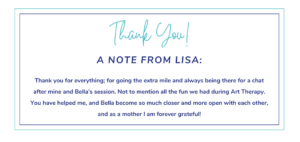Case Study: Dyadic Art Therapy for mother and daughter affected by domestic abuse
Introduction
Dyadic Art Therapy is a joined-up approach to art therapy involving children and their parents or caregivers in joint art therapy sessions. This case study looks at how Dyadic Art Therapy can help strengthen and nurture the connection between a mother and daughter, whose lives have been affected by domestic abuse.
Dyadic Art Therapy has unique characteristics that make it an affective intervention for parents and children affected by domestic abuse. It can help facilitate them to safely communicate their experiences of domestic abuse, make sense of what can seem disconcertingly chaotic, and increase their understanding and empathy for each other and themselves. Research suggests that domestic abuse can have a detrimental impact on the parent-child relationship and therefore, presents as having a heightened need for psychological support.
Background and reason for referral
For confidentiality purposes, the mother will be referred to as Lisa and the daughter as Bella in this case study. Lisa, aged 30, has been a victim of significant domestic abuse since she was a child and has been in multiple abusive intimate adult relationships. Lisa’s two children were taken into care due to witnessing and experiencing domestic abuse from her ex-partner at the time.
When Lisa was referred to therapy, she was 4-months pregnant with her third child and in a new healthy relationship. Bella, aged 10, has been in care for four years, living with a foster carer and was still experiencing the impact of trauma from the abuse she witnessed and experienced at home whilst she was in her mother’s care. She had great anxieties about her mother and her ability to protect her; Bella experienced flashbacks and night terrors in relation to what had happened.
Lisa received one-to-one support and made great progress and evidenced that she had the capacity to parent her children and safeguard them from future harm. However, it was felt that the rehabilitation plans could not be progressed until Bella received support to help her to process what had happened, her experiences of the domestic abuse, and to help her re-establish the relationship she had with her mother to gain the trust that she will keep her safe. Social care referred Lisa and Bella to receive Dyadic Art Therapy at NIDAS to do this piece of work with the aim for the children to go back to Lisa’s full-time care.
Engagement in Dyadic Art Therapy process
Lisa and Bella attended 12 sessions of Dyadic Art Therapy in total. Lisa and Bella both had a one-to-one assessment with the art therapist, prior to the joint sessions starting. This allowed the art therapist to better understand their individual needs and their views. In the first joint session, they spoke about what aims they would like to achieve and what they both wanted to get out of the experience. Their aims were to feel more connected and to understand each other better.
The Dyadic Art Therapy sessions were delivered using a psychodynamic, trauma informed, directive approach with specific aims and themes in mind. Lisa and Bella were seen by the art therapist, once a week for an hour.
The main dyadic approaches that were used in therapy were child-led with mother as helper or witness and a joint engagement approach. Through creative processes and activities, these approaches created relational engagement and attempted to develop the capacity for reflective functioning for both the child and mother. All the activities embraced and enhance the child’s self-worth and encouraged imagination, creativity, and communication. The main themes that were explored in the sessions were around feelings, safety, building trust, and enhancing communication.

Outcome
Through a short course of Dyadic Art Therapy, there were positive changes and developments in Lisa and Bella’s relationship that enabled a stronger emotional safety and stability after being affected by domestic abuse, and shared feelings were openly expressed and communicated.
“Dyadic art therapy made Bella and I open up a lot more about our feelings and I feel like we have a better understanding of each other” – Lisa.
Bella’s trust in her mother developed and Lisa was able to attune into Bella’s feelings, offering comfort and advice but also learning to put boundaries in place where needed. The joint image-making created special experiences where Lisa and Bella were able to build a sense of closeness that were not always available or acknowledged whilst Bella was in care. Lisa and Bella had many moments of having fun together, painting with joy and laughter, creating a mutual, playful dialogue, and where symbolic metaphors were created and shared; it was considered their special time.
The sessions allowed opportunities for them to express their fears and hopes for their future. They both had a real passion for art making, which allowed them to engage therapeutically and reflectively, and the artworks created became of great value to them and were seen as a symbol of new beginnings, which they both deeply deserved.
Conclusion
Dyadic Art Therapy provided this mother and daughter a safe space for feelings and experiences to be openly communicated, facilitated by the art therapist, where they had not been shared or expressed before. An increase in emotional safety and stability was achieved – a vital first stage in recovering from domestic abuse. The sessions enabled the parent-child relationship to strengthen and increased communication, empathy, understanding, and enhanced a positive attachment.
“It’s been very helpful to reconnect, and our relationship is better”- Lisa.
Since attending Dyadic Art Therapy at NIDAS, Bella and her brother have returned to Lisa’s full-time care and have both settled in well. They now have a new baby brother and are finally enjoying being a family, away from domestic abuse.

Art Therapy
Are you interested in learning more about art therapy? Click here or contact us for more information by calling 01623 683 250 or email [email protected].